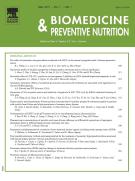Co-administration of selenium but not iron prevents fluoride toxicity in rats - 15/06/13


Abstract |
Fluoride toxicity is known to be associated with oxidative stress, altered antioxidant defense mechanism and DNA damage. The current study was undertaken to evaluate the efficacy of co-administration of selenium (6.3μM) and iron (7.2μM) with fluoride (50ppm) in preventing fluoride-induced oxidative injury, DNA damage and in reducing body fluoride burden in rats. The data suggested that sodium fluoride administration, (50ppm, in drinking water) in rats led a significant oxidative stress which is evident from elevated levels of reactive oxygen species (ROS), lipid peroxidation (TBARS) and reduced activities of antioxidants such as superoxide dismutase (SOD), catalase and glutathione peroxidase (GPx) in rats. Co-administration of selenium with fluoride led to a significant recovery in blood and tissue ROS and TBARS levels accompanied by restored activities of antioxidant enzymes studied. Interestingly, selenium also exhibited a remarkable effect in preventing DNA damage in blood and fluoride accumulation in blood and soft tissues. In contrast, administration of iron with fluoride provided significant beneficial effects on blood oxidative stress and DNA damage but failed in reducing tissue oxidative stress conditions and fluoride concentration. Thus, present study provides some useful data concerning beneficial role of selenium against fluoride toxicity by virtue of its ability to eliminate fluoride from target organs and providing recovery in altered biochemical variables.
Le texte complet de cet article est disponible en PDF.Keywords : Fluoride toxicity, Co-administration, Protection, Selenium, Iron, Rats
Plan
Vol 3 - N° 2
P. 113-120 - avril 2013 Retour au numéroBienvenue sur EM-consulte, la référence des professionnels de santé.
L’accès au texte intégral de cet article nécessite un abonnement.
Déjà abonné à cette revue ?

